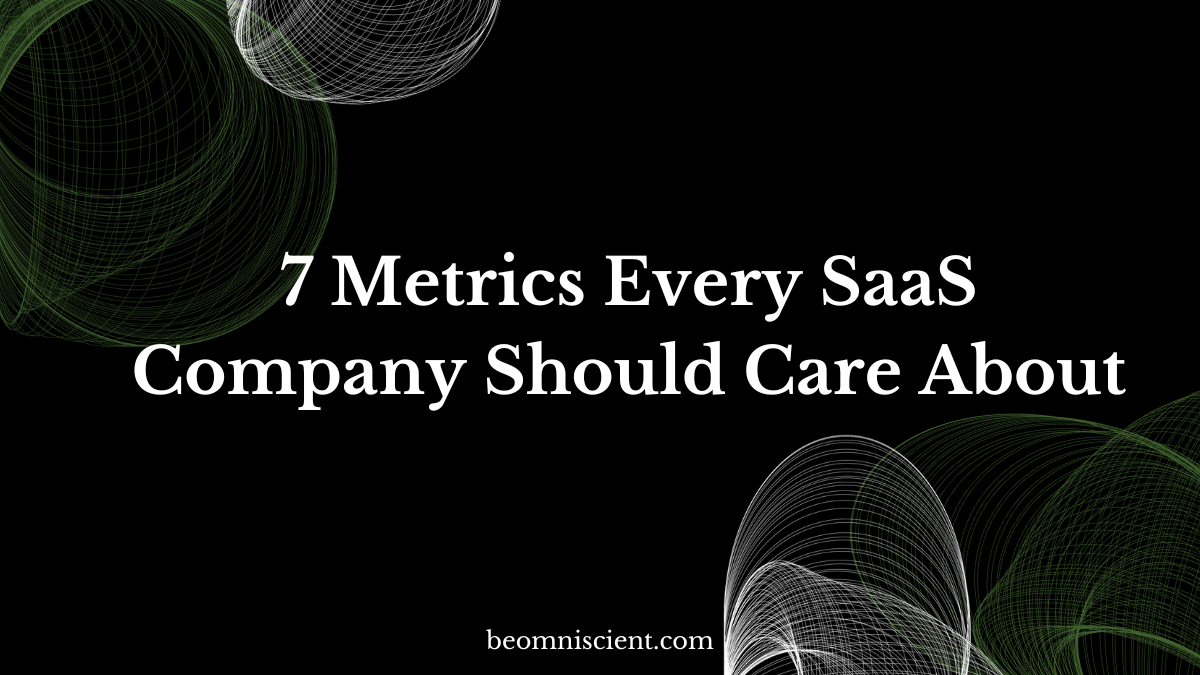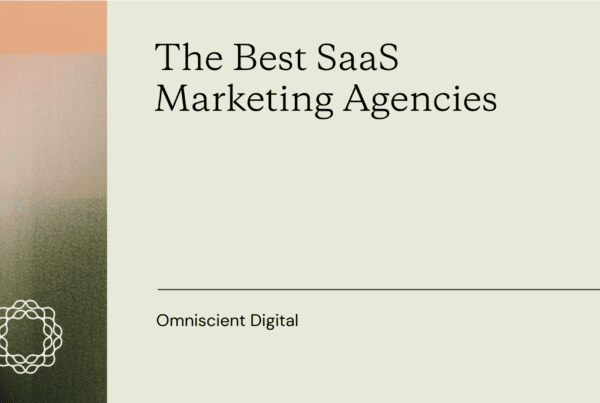
Building client relationships is the primary objective of most Software as a Service (SaaS) businesses. Relationship building is the best possible technique to generate recurring revenue. As opposed to typical ecommerce enterprises that aim to attract new buyers, this effective growth strategy elevates the game.
Focusing on metrics that matter is crucial to the advancement of a SaaS product. This article will go through the 7 metrics every SaaS company should care about. But before getting into the details, here is an overview of SaaS metrics.

What are SaaS Metrics?
SaaS companies deliver licensed and subscription-based applications to users through the internet. This software can be accessed remotely on any computer or mobile device and prevents the risk of losing data in the event of hardware failure. Furthermore, it eliminates the need for self-maintenance since a cloud service provider hosts and supports the software.
A future-oriented SaaS business relies on long-term profitability, which makes financial operations more complex. Traditional business metrics simply miss the mark when it comes to measuring SaaS productivity. Ultimately, a successful SaaS firm can be established if the essential SaaS metrics are observed.
Basically, SaaS metrics can determine how well a SaaS organization performs. When appropriately selected, they offer real-time progress indicators and deliver significant estimates on customer retention. Moreover, they disclose how SaaS companies can outperform their competitors, as well as those providing on-premise software. We’ll discuss more what SaaS metrics are in the succeeding sections.
What Makes a SaaS Company Unique?
SaaS and other companies with recurring income differ from other firms because their revenues are earned over a longer period. Customer satisfaction and brand loyalty are vital to increase their profits. Conversely, the loss is highly probable if the clients felt disappointed and immediately canceled their service.
Renewals are the main driving force of the SaaS industry. The time it takes to recoup the costs of gaining new subscribers can range from months to years. The money stream is cut off, and the operations are rendered terminal if users do not renew their subscriptions. With this in mind, existing customers should be given priority.
Additionally, SaaS businesses can be conveniently managed and controlled without incurring costly infrastructure deployment expenditures. Since the application is hosted over the cloud, there is no need to invest and maintain any additional hardware. Cloud-based software accessibility is possible on an internet-connected device.
Another important aspect that sets SaaS organizations apart from rival businesses is the application of continuous monitoring. Effective monitoring is necessary as more SaaS applications are hosted in the cloud to guarantee top performance, availability, and security. Ongoing monitoring offers useful information about the general state and functionality of the SaaS infrastructure. It makes it possible for businesses to monitor crucial metrics like server uptime, response times, and resource usage. SaaS companies may proactively spot and resolve any problems that might affect customer experience or interfere with service delivery like preventing server downtime by selecting a reliable dedicated server or web hosting provider and closely monitoring these KPIs.
In conclusion, using continuous monitoring enables SaaS businesses to maximize performance, raise client satisfaction, and make sure their recurring revenue model is successful in the long run.
7 Metrics Every SaaS Company Must Consider
SaaS is a must-have service for any company seeking to grow. A recent study found that the SaaS global market size will reach $ 896.2 billion by 2030. The expansion is impacted by various mid-sized industries’ wide range of applications. It includes customer relationship management (CRM), enterprise resource solution, supply chain management, web collaboration, on-demand human resources (HR) solutions, and product life cycle management.
SaaS software and cloud service providers are a rapidly developing technology that enables businesses to store and access their data in the cloud. Regarding the benefits of cloud computing, SaaS stands out for its capacity to scale, be reliable, and be flexible. Furthermore, SaaS software reduces an organization’s IT infrastructure costs. As a result, SaaS apps are in high demand.
For future-oriented SaaS companies in a fast-paced market, metrics provide guidance. These seven key metrics give SaaS businesses perspective on the effectiveness of their growth strategy and highlight areas for improvement.
1. Monthly Recurring Revenue
Monthly recurring revenue (MRR) is the anticipated total revenue from all active subscribers in a month. This SaaS metric analyzes the company’s current financial state. It is also used to forecast future earnings based on the number of ongoing contracts. One-time charges are disregarded in the MRR while discounts, coupons, and recurring add-ons are included.
The MRR can be calculated easily. Just take the average revenue per month and multiply it by the number of average monthly recurring revenue per user (ARPU). To compute MRR for twelve-monthly subscriptions, the annual price is divided by 12 and then multiplied by the number of clients on the yearly plan.
2. Annual Run Rate
The annual run rate (ARR) is a vital SaaS metric used to measure the yearly predictable and recurring revenue earned. Often, it includes fixed subscription or recurring costs and eliminates one-time fees or variable charges. Moreover, it can only be calculated if your clients sign one-year contracts or longer.
SaaS firms must assess their yearly recurring income to determine continuing sustainability. Unlike MRR, solving for the ARR is more complex. To calculate the formula, add the overall revenue from annual subscriptions to the total income from expansion, plus the total loss due to churn and contraction.
3. Net Revenue Retention
Recurring income earned over a certain time frame from current customers is a SaaS metric called net revenue retention (NRR). To determine NRR, deduct churn proceeds and account contraction from beginning recurring revenue and account expansion. Next is to divide them by the initial quantity.
As per NRR, client upgrades, downgrades, and churn rates can gauge the customer base growth potential. New customers are, therefore, excluded.
4. Customer Lifetime Value
Customer lifetime value (CLV) determines how much income a subscriber usually generates throughout the life of the business relationship. It is one of the most relevant SaaS metrics to consider. A high CLV indicates excellent client satisfaction and brand commitment. It also denotes that the quality of SaaS products and services is greatly preferable for the target market.
CLV can give a better valuation of how customers spend. Its computation divides the ARPU by the customer churn rate. To put it another way, take the revenue from a client less the amount spent on serving them, and then divide them by how long they remain profitable before leaving.
5. Churn
Churn is another key SaaS metric. It refers to the percentage of SaaS customers who cancel their subscriptions during a specific period. Essentially, SaaS companies should keep their churn rate as low as possible. Obtaining new customers is far more expensive than retaining existing ones.
There are various approaches to measuring SaaS churn. The easiest formula is to divide the number of customer churn by the overall subscribers at the beginning of the duration. However, simple computation can mislead SaaS analysis during times of rapid expansion. A more reliable churn rate can be calculated by using the middle of the month’s total quantity of users instead of the current customers since the period’s start.
6. Customer Acquisition Cost
The cost of acquiring a new customer is known as customer acquisition cost (CAC). While this metric is utilized in a broad range of businesses, SaaS is particularly dependent on it for development. CAC can be calculated by the total sales and marketing expenses divided by the number of clients gained during the period.
Most SaaS startups spend their time and resources pursuing potential subscribers before achieving a complete return on investment. A growing SaaS company can begin earning profits by evaluating the amount required from each client. Therefore, it is essential to predict how long it will take to recover CAC.
7. Net Promoter Score
Net Promoter Score (NPS) is one of the most effective SaaS metrics for assessing customer satisfaction. It delivers insight regarding brand impression, expansion, and buyer behaviors. Moreover, it can be revealed by conducting a simple online survey. Hence, it is an ideal option even for small SaaS firms because it doesn’t need a team of qualified researchers.
NPS surveys collect data that can boost the company’s reputation and establish a loyal customer base, improving customer retention. The respondents are classified as detractors who chose zero to 6, passives who picked 7 to 8, and promoters who selected 9 to 10. To calculate for NPS, the rate of detractors is deducted from the percentage of promoters.
Success Factor Tips for SaaS
Numerous SaaS concepts exist, but a valuable product is necessary for a firm’s long-term survival. The best place to begin is by identifying the user problem. If the SaaS product and service resolve the concerns, there will be a significant opportunity to retain more customers and acquire many prospective subscribers.
However, even if your product is exceptional, problems may arise, and help will be necessary. Therefore, SaaS providers should commit to and plan for continuous client support. A team of professionals from a software development company may assist with anything from design to software development to market research and metric selection.
Each SaaS company’s pricing structure is unique. Thus, examining what would maximize profitability is important. A possible solution is a tiered payment system that delivers a hybrid of free and paid services. In addition, marketing competition can be intense, but advertising a SaaS business can bring it to the notice of the right customers.
Improve Your Business with SaaS Metrics
Establishing a SaaS organization single-handedly or with a small budget is challenging. For a SaaS solution to be successful, each aspect must be effective. Therefore, it is critical to check the current financial status of a SaaS company and formulate a feasible expansion strategy. With the appropriate SaaS metrics, a SaaS business’s performance can be evaluated in real-time and reliable data can be provided for further advancement.
Get the Field Notes
Weekly learnings from working on B2B content & SEO for dozens of companies.



